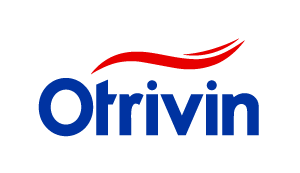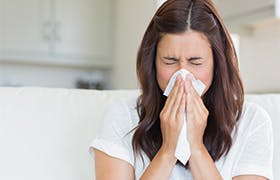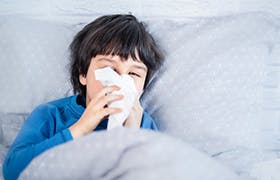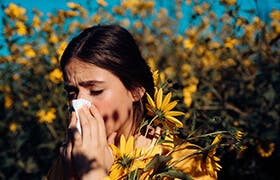
The science behind allergic rhinitis.
The immune system’s role is to protect the body from viruses, bacteria and various diseases. Allergic Rhinitis simply refers to inflammation of the mucous membrane of the nose, caused by the body’s immune system overreacting to an allergen. Allergic Rhinitis is extremely common. In fact, it affects 10% to 30% of the world’s population.3
What causes allergic rhinitis?
Allergy symptoms occur when your body’s immune system wrongly identifies a harmless substance as dangerous. These substances – such as pollens, pollutants, or dust mites – trigger the production of immunoglobulin E antibodies (IgE antibodies). Allergies can also be caused by certain foods.
The IgE antibodies bind to the body’s defence cells, known as mast cells, which triggers the release of chemicals such as histamine that are part of your body’s inflammatory response. These chemicals act on the cells, nerves and vessels of the nose to produce the typical symptoms of an allergy – sneezing, itching, congestion and a runny nose.3
Allergens exist in many different forms. Common forms include2:
- Pollutants
- Pollens from trees, grasses or weeds
- Dust mites
- Pet dander
- Pet hair
- Moulds
- Certain foods

Flower Pollen

Tree Pollen

Dust Mites

Pet Dander
What are the symptoms of allergic rhinitis?
People with allergic rhinitis can start to experience symptoms just minutes after breathing in an allergen such as dust mites or pollutant. The body’s immune system may react with the following common symptoms:1
- Sneezing
- Itchy nose
- Runny nose
- Blocked nose
- Itching of the mouth and throat
- Postnasal drip (the sensation of mucus running down the back of the throat)
- Watery, red or sore eyes
How can I reduce the risk of allergic rhinitis symptoms?
Avoiding the triggers of an allergic response is an important part of managing it. It is sometimes possible to prevent the symptoms of allergic rhinitis by taking precautions such as:1
- Staying indoors when the pollen count/ pollution/dust is high. Avoid going out in months when pollution, dust, and pollen count are high.
- Trying to avoid walking in grassy, open spaces. This is particularly important during the early morning, early evening, and during mowing, when the pollen count is high.
- Keeping windows and doors closed. This would prevent exposure to dust and pollutants.
- Wearing sunglasses or glasses. This is to stop pollen/dust getting in your eyes when you’re outdoors and taking a shower when you get home to remove it from your skin.
- Using a nasal wash. This can help to clean your nostrils of pollutants, pollens and dust.
How can I treat my allergic rhinitis symptoms?
Unfortunately, there’s currently no cure for allergic rhinitis. The good news, however, is that there are some ways to help relieve your symptoms. Treatment options for allergic rhinitis relief include antihistamines, corticosteroids, nasal decongestants and nasal irrigation:2,3
- Antihistamines help counter the effects of histamine, the chemical released within your body when an allergic reaction takes place. Antihistamines are found in eyedrops, nasal sprays and, most commonly, oral tablets and syrup
- Intranasal corticosteroids can reduce the inflammation of the inside of your nose and significantly reduce nasal congestion as well as sneezing, itching and a runny nose. In order for you to get the best from intranasal corticosteroids it is recommended that you start using them two weeks before you are first exposed to the particular allergen that causes your hay fever
- Nasal Decongestants like Otrivin Moisturising Paediatric Nasal Drops can help to open up blocked nasal passages that have become inflamed as a result of allergic conditions. They also provide further moisturisation to the nasal passage.7,8
How can I manage my allergic rhinitis for longer periods of time?
There are things that people with allergic rhinitis can think about adopting into their routine to manage their symptoms long-term. Your nose is the first line of defence when it comes to airborne allergens: it filters particles from the air you breathe in by trapping them in the mucus and hairs inside the nose. They are then transported to the back of your throat and swallowed or coughed out.
A build-up of allergens in the nose can affect this process and here’s where the system can break down, leading to inflammation and a blocked nose.
Otrivin Breathe Clean.
Otrivin Breathe Clean is a daily solution that can help keep nature’s pollution filter (the nose) working. This gentle saline formula can be used every day to help you keep your nose clear of dust and other pollutants, and wash away any excess mucus produced during a cold or due to allergies.6
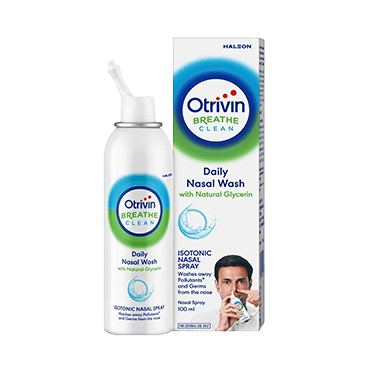
Otrivin Moist P Nasal Drops.
Otrivin Moisturising Paediatric is a decongestant suitable for children that contains xylometazoline in aqueous solution of sorbitol and hypermellose. In addition to providing relief from congestion, it prevents drying and irritation of nasal mucosa (skin lining of nose). Starts its action in 2 mins and provides relief from up to 12 hours.8
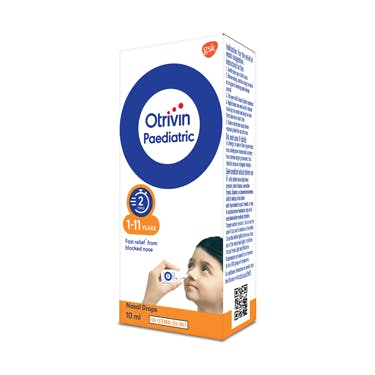
References:
- NICE CKS. Allergic rhinitis. Available from https://cks.nice.org.uk/allergic-rhinitis#!backgroundSub:2 (last accessed March 2020)
- American College of Allergy, Asthma and Immunology. Allergic Rhinitis. Available from: https://acaai.org/allergies/types/hay-fever-rhinitis (last accessed March 2020)
- World Allergy Organization. 2011-2012 Executive Summary. In WAO White Book on Allergy. Pawankar R, Walkter Canonica G, Holgate ST, et al, eds. 2011:11–20. World Allergy Organisation
- NHS Inform. Hay fever. Available from: https://www.nhsinform.scot/illnesses-and-conditions/immune-system/hay-fever (last accessed March 2020)
- Katelaris CH, Beggs PJ. Climate change: allergens and allergic diseases. Intern Med J. 2018;48:129–134
- Otrivin Breathe Clean
- Otrivin Moisturising Adult
- Otrivin Moisturising Paediatric
Show all references
Close references

